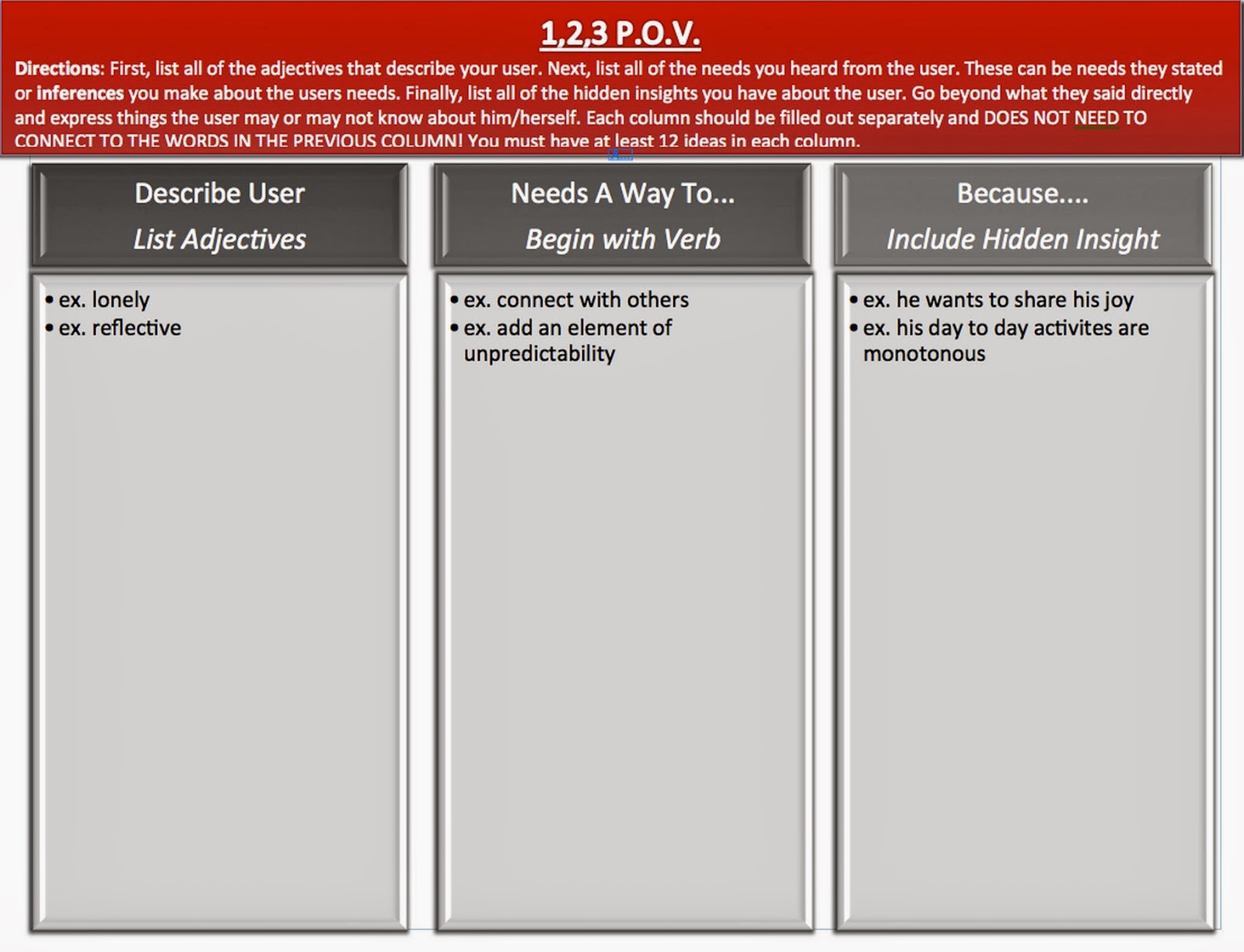Above you can see an example of an empathy map conducted during a recent workshop with educators. This example was generated from a 3 minute interview with an elementary school principal. I am adding this visual to give people an idea of what it might look like to “triangulate” evidence to make an inference. In this particular example, we see single and double lines pointing from the concrete items on the left to the inferred items on the right. For example, “she created a student survey” is connected to her animated gestures and speaking, which helped the participants to infer that she sees “students’ success as more important than her own.” In that sense, we have literally drawn a triangle between several items on our empathy map. With more time, this can be repeated a great many times until you have a robust set of inferences.
Okay, so what comes next? At REDlab and d.loft we do something called 1,2,3 POV which is a scaffold for the construction of a Point of View Statement (POV).
Above is a worksheet for this activity we have used in d.loft. The way it works is simple. First you (or preferably a team working with the data) write down as many adjectives as you can about the person interviewed. I suggest using a personality adjective list or adjective wheel for this (collected from a simple google search) since without fail we are tempted to call our subjects “passionate” which is a bit too generic for capturing the rich nature of an individual’s point of view. Next, we make a list of all of the possible needs our subject might have. In the world of the d.school and d.loft, we avoid beginning these with verbs because that is getting a bit too specific with our insights at this point in the process. There is a big difference between saying “Johnny needs a straight As” and “Johnny needs a way to improve his homework habits”. In one case, we are applying our own perspective and values on Johnny and in the other, we are trying to get closer to his perspective, to figure out what is going on with him. Starting with a verb is a handy trick for doing this.
Following the example from the educator workshop, we can see this activity in progress. Note how we crossed out “Nicole needs to add more time” because needing time is essentially a noun and this is what we want to avoid. At this stage in the activity, there is no connection between either column, the group is just brainstorming adjectives and needs. We are now making even more inferences about our subject. So how are these inspired? These responses come from both the raw interview data (or text or video or whatever your data source) or directly from the empathy map.
Once you have populated the first two column, you begin the synthesis process again by making connections. You link an item from column 1 to an item in column 2 and complete it with an item in column 3. In the example above we see things like “Energetic Nicole needs a way to optimize activities because she doesn’t have enough time in the day” and “Thoughtful Nicole needs a way to meet the demands of students in a student-centered way because she does not want kids to be afraid”.
The next step in the design thinking process is called a Point of View Statement. This is where you pick the most insightful one or two statements from the previous activity and fill it in to the template. As a design thinking practitioner and coach, I believe this is the most difficult part of the process. Spending some time workshopping these with others can be painful but is extremely valuable. The more you practice this step, the more you see that changing a single word or phrase changes the entire insight.
Depending on what your activity goals, you may want to pursue a single point of view or concurrent point of view statements. In either case, this multi-step process has gotten you much closer to understanding the perspective of another than a simple guess. As I have mentioned before, this can be helpful in human-centered design activities, analysis of fictional texts, preparing to write-up or interviews, or any other activities where you want to get outside of yourself and into the shoes of someone else.
Citation:
Zielezinski, M. (2014). Empathy Mapping and Point of View Statements. Social Media for Learning. Retrieved March 10, 2014, from http://socialmedia4learning.com/visualizations/empathy-mapping-and-point-of-view-statements/





An empathy map is a collaborative tool teams can use to gain a deeper insight into their customers. Use this empathy map template to easily draw empathy maps and learn more about them.
ReplyDeleteThis blog is pretty good to learn new information, you are doing well. Keep it up!
ReplyDeletehttps://blog.mindvalley.com/empathy-examples/